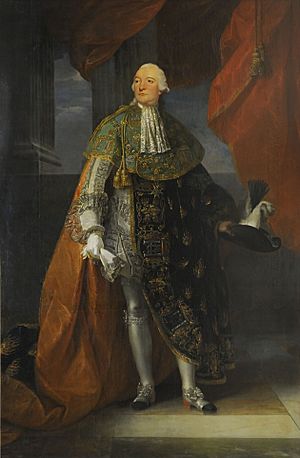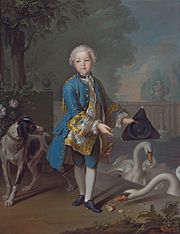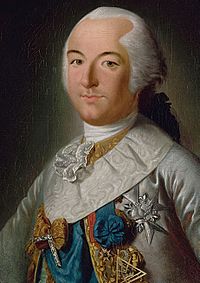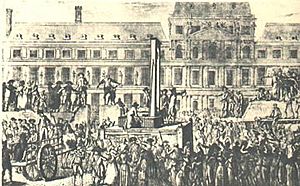Louis Philippe II, Duke of Orléans facts for kids
Quick facts for kids Louis Philippe IIPhilippe Égalité |
|||||
|---|---|---|---|---|---|
| First Prince of the Blood Duke of Orléans |
|||||

Portrait by Antoine-François Callet
|
|||||
| Born | 13 April 1747 Château de Saint-Cloud, Saint-Cloud, France |
||||
| Died | 6 November 1793 (aged 46) Paris, France |
||||
| Spouse | |||||
| Issue |
|
||||
|
|||||
| House | Orléans | ||||
| Father | Louis Philippe I, Duke of Orléans | ||||
| Mother | Louise Henriette de Bourbon | ||||
| Religion | Roman Catholicism | ||||
| Signature | |||||
Louis Philippe II (born Louis Philippe Joseph; April 13, 1747 – November 6, 1793) was an important French noble. He was a cousin of King Louis XVI and one of the richest people in France.
He became known for supporting the French Revolution. He wanted to change France from an absolute monarchy (where the king had all the power) to a constitutional monarchy (where the king's power was limited by laws).
In 1792, during the Revolution, Louis Philippe changed his name to Philippe Égalité. This new name meant "equality." Sadly, even though he supported the Revolution, he was executed by guillotine in 1793 during a time called the Reign of Terror. His son, also named Louis Philippe, later became King of the French in 1830.
Contents
Early life

Louis Philippe Joseph d'Orléans was born at the Château de Saint-Cloud, a large home near Paris. His parents were Louis Philippe d'Orléans and Louise Henriette de Bourbon. He was part of the House of Orléans, which was a branch of the French royal family.
Philippe had an older sister who died as a baby. His younger sister, Bathilde d'Orléans, was born in 1750.
Succession to titles
When Philippe was born, his first title was the Duke of Montpensier. In 1752, his grandfather died, and Philippe became the Duke of Chartres.
In 1785, his father passed away. Philippe then became the Duke of Orléans. This made him the head of the House of Orléans, one of the wealthiest noble families in France. He also became the Premier Prince du Sang, or First Prince of the Blood. This meant he was next in line to the throne after the king's closest family.
Personal life
Marriage

On June 6, 1769, Louis Philippe married Louise Marie Adélaïde de Bourbon. Their wedding took place at the chapel of the Palace of Versailles. Louise Marie Adélaïde was the daughter of his cousin, Louis Jean Marie de Bourbon, Duke of Penthièvre. Her father was one of the richest men in France.
When her father died, Louise Marie Adélaïde was set to become the richest woman in France. This huge dowry (wealth brought by a bride) made the already rich House of Orléans even wealthier. It gave Louis Philippe a lot of political power in the royal court.
Military career
In 18th-century France, it was common for royal princes to have high military positions. From a young age, Philippe d'Orléans was interested in the navy. He trained in the Navy for three years.
By 1776, he was a high-ranking officer called a Chef d'Escadre. He commanded a division of ships.
When the war between France and Britain started in 1778, Orléans was a Lieutenant général des Armées navales. He was in charge of a whole squadron of ships. At the Battle of Ushant on July 27, 1778, his squadron was at the front of the French fleet.
After the battle, Orléans returned to Paris. He claimed the battle was a great victory and was welcomed as a hero. However, it soon became clear that the battle was more of a tie. This damaged Orléans' reputation. He left the Navy and tried to join the army, but he was not given a position.
Role in the French Revolution

Liberal ideas
Philippe d'Orléans believed in new ideas that were popular during the Age of Enlightenment. He was a member of the Society of the Friends of the Constitution. He strongly supported ideas from thinkers like Voltaire and Jean-Jacques Rousseau. He wanted France to have a more fair and democratic government.
He believed in separating church and state and having a king with limited power. He also spoke out against feudalism (an old system of land ownership) and slavery.
Philippe was also the Grand Master of the Grand Orient de France, a powerful group of freemasonry. He held this position from 1771 to 1793. He later stepped away from Freemasonry in 1793.
He greatly admired the British constitutional monarchy. He strongly wanted France to adopt a similar system, instead of the absolute monarchy it had.
Palais-Royal
When Philippe became the new Duke of Orléans, he inherited the Palais-Royal. In 1792, this palace became known as the Palais-Égalité. This was because he opened its doors to everyone in France, no matter their social class.
He built shops and cafés there where people could meet and talk. Soon, it became a lively center for social life in Paris. Since the police could not enter the Duke's private property, it also became a place where revolutionary ideas were discussed. Many members of the National Assembly said the Palais-Royal was the "birthplace of the Revolution." Philippe wanted to create a place where people could gather, which he felt was important for democracy.
Before the Revolution began in July 1789, Philippe d'Orléans did many things to gain public support. He supported a plan for local assemblies and sold artwork to help the poor. He also gave money to cheering crowds during a riot.
Leadership in the Estates-General
Philippe d'Orléans was chosen to be part of the Estates General by three different areas. He was a noble, part of the Second Estate. However, he felt a strong connection to the Third Estate, which represented most of the common people. The Third Estate had many members but little power.
When the Third Estate decided to form the National Assembly, Philippe was one of the first nobles to join them. He led 47 other nobles to leave their estate and join the National Assembly. This was a very important step in uniting the nobility and the Third Estate.
Women's March on Versailles and exile
One of the main accusations against Philippe d'Orléans was that he started the Women's March on Versailles on October 5, 1789. Some people believed he did this to overthrow the King and gain popularity. He was accused of funding the riots.
The Marquis de Lafayette, a powerful figure at the time, suggested that d'Orléans go to the British Isles. Lafayette saw d'Orléans as a threat to his own power in the Revolution. His main goal was to get Philippe out of France.
At first, Philippe did not want to leave France during these difficult times. But after a lot of pressure from Lafayette, he left. While in exile, he wrote that he strongly wanted to return to France. When he did come back, he never had the same power he had before. People who did not support him called him a coward for fleeing. However, he kept his position in the National Assembly until it ended in September 1791.
Citoyen Égalité
Philippe d'Orléans felt uncomfortable with his royal name because of his democratic beliefs. He felt his name did not match his ideas of equality. So, he asked the Paris Commune (French Revolution) to change his name, and they agreed.
Soon after the September Massacres in 1792, he changed his last name to Égalité, which means "equality" in English. "Liberty, Equality, Fraternity" was the motto of the French Revolution. He felt this new name showed he was a symbol of the French people and their fight for freedom.
Égalité also gained his new name because he was known for being generous to the poor. He often gave food and money to those in need. He also provided shelter for homeless people during the very cold winter of 1788–1789.
Relationship with King Louis XVI
Philippe d'Orléans was a relative of King Louis XVI, but they never had a good relationship. When Philippe became Duke of Orléans, he also became the Premier Prince du Sang. This meant he was the most important person in the kingdom after the king's immediate family. Because of this, some people thought Philippe wanted to take the king's throne.
Philippe and the King's wife, Marie Antoinette, also disliked each other. The King's refusal to give Philippe a position in the army after the Battle of Ushant also made Philippe unhappy with the King.
One surprising event was when Philippe voted for Louis XVI's execution. He had promised friends he would vote against it. But when surrounded by a radical group called the Montagnards, he changed his mind. A majority of 75 votes was needed to sentence the King, and 394 votes were cast for his death. The King was very shocked by this news. He said:
"It really pains me to see that Monsieur d'Orléans, my kinsman, voted for my death."
Death
On April 1, 1793, a new law was passed. It said that anyone suspected of helping France's enemies would be punished. At this time, Égalité's son, Louis Philippe, who was a general, joined General Dumouriez in a plan to meet with the Austrians, who were enemies of France.
Even though there was no proof that Égalité himself was a traitor, his son's connection to Dumouriez was enough. Égalité and his son Louis Charles, Count of Beaujolais were arrested on April 4, 1793. Other members of the Bourbon family in France were also arrested in the following days.
He was held in Fort Saint-Jean in Marseille for several months. Then he was sent back to Paris. On November 2, 1793, he was imprisoned at the Conciergerie. He was tried by the Revolutionary Tribunal on November 6 and sentenced to death. He was executed by guillotine on the same day.
Issue
The Duke and Duchess of Orléans had six children:
- A daughter (died at birth, October 10, 1771)
- Louis Philippe I, King of the French (October 6, 1773 – August 26, 1850), who became King of the French (1830–1848)
- Louis Antoine Philippe d'Orléans (July 3, 1775 – May 18, 1807), died while in exile in England
- Françoise d'Orléans Mademoiselle d'Orléans (twin sister of Adélaïde) (1777–1782)
- Louise Marie Adélaïde Eugénie d'Orléans (August 23, 1777 – December 31, 1847)
- Louis Charles d'Orléans (October 17, 1779 – May 30, 1808), died while in exile in Malta
Titles and succession
| Styles of Louis Philippe II, Duke of Orléans |
|
|---|---|
 |
|
| Reference style | His Serene Highness |
| Spoken style | Your Serene Highness |
- April 13, 1747 – February 4, 1752 His Serene Highness the Duke of Montpensier
- February 4, 1752 – November 18, 1785 His Serene Highness the Duke of Chartres
- November 18, 1785 – November 6, 1793 His Serene Highness the Duke of Orléans
- He received this last title after his father's death. He was also known as the First Prince of The Blood.
Popular culture
Philippe d'Orléans has been shown in several films:
- The 1938 film, Marie Antoinette, where he was played by Joseph Schildkraut.
- The 2001 film The Lady and the Duke, where he was played by Jean-Claude Dreyfus.
Philippe d'Orléans was also a character in the anime "The Rose of Versailles" by Riyoko Ikeda.
See also
 In Spanish: Luis Felipe II de Orleans para niños
In Spanish: Luis Felipe II de Orleans para niños


